参考地址:
1、http://www.scipy-lectures.org/packages/scikit-learn/index.html
2、http://scikit-learn.org/stable/
3.6. scikit-learn: machine learning in Python
See also
Data science in Python
- The Statistics in Python chapter may also be of interest for readers looking into machine learning.
- The documentation of scikit-learnis very complete and didactic.
Chapters contents
- Introduction: problem settings
- Basic principles of machine learning with scikit-learn
- Supervised Learning: Classification of Handwritten Digits
- Supervised Learning: Regression of Housing Data
- Measuring prediction performance
- Unsupervised Learning: Dimensionality Reduction and Visualization
- The eigenfaces example: chaining PCA and SVMs
- Parameter selection, Validation, and Testing
- Examples for the scikit-learn chapter
3.6.1. Introduction: problem settings
3.6.1.1. What is machine learning?
3.6.1.2. Data in scikit-learn
The data matrix
- n_features: The number of features or distinct traits that can be used to describe each item in a quantitative manner.
A Simple Example: the Iris Dataset
The application problem
As an example of a simple dataset, let us a look at the iris data stored by scikit-learn. Suppose we want to recognize species of irises. The data consists of measurements of threedifferent species of irises:
 |  |  |
|---|---|---|
| Setosa Iris | Versicolor Iris | Virginica Iris |
Quick Question:
If we want to design an algorithm to recognize iris species, what might the data be?
Remember: we need a 2D array of size
[n_samples x n_features].
- What would the
n_samplesrefer to?- What might the
n_featuresrefer to?
i must be a similar kind of quantity for each sample.Loading the Iris Data with Scikit-learn
Scikit-learn has a very straightforward set of data on these iris species. The data consist of the following:
- Features in the Iris dataset:
- sepal length (cm)
- sepal width (cm)
- petal length (cm)
- petal width (cm)
- Target classes to predict:
- Setosa
- Versicolour
- Virginica
scikit-learn embeds a copy of the iris CSV file along with a function to load it into numpy arrays:
>>> from sklearn.datasets import load_iris
>>> iris = load_iris()
Note
Import sklearn Note that scikit-learn is imported as sklearn
The features of each sample flower are stored in the data attribute of the dataset:
>>> print(iris.data.shape)
(150, 4)
>>> n_samples, n_features = iris.data.shape
>>> print(n_samples)
150
>>> print(n_features)
4
>>> print(iris.data[0])
[ 5.1 3.5 1.4 0.2]
The information about the class of each sample is stored in the targetattribute of the dataset:
>>> print(iris.target.shape)
(150,)
>>> print(iris.target)
[0 0 0 0 0 0 0 0 0 0 0 0 0 0 0 0 0 0 0 0 0 0 0 0 0 0 0 0 0 0 0 0 0 0 0 0 0
0 0 0 0 0 0 0 0 0 0 0 0 0 1 1 1 1 1 1 1 1 1 1 1 1 1 1 1 1 1 1 1 1 1 1 1 1
1 1 1 1 1 1 1 1 1 1 1 1 1 1 1 1 1 1 1 1 1 1 1 1 1 1 2 2 2 2 2 2 2 2 2 2 2
2 2 2 2 2 2 2 2 2 2 2 2 2 2 2 2 2 2 2 2 2 2 2 2 2 2 2 2 2 2 2 2 2 2 2 2 2
2 2]
The names of the classes are stored in the last attribute, namelytarget_names:
>>> print(iris.target_names)
['setosa' 'versicolor' 'virginica']
This data is four-dimensional, but we can visualize two of the dimensions at a time using a scatter plot:

Excercise:
Can you choose 2 features to find a plot where it is easier to seperate the different classes of irises?
Hint: click on the figure above to see the code that generates it, and modify this code.
3.6.2. Basic principles of machine learning with scikit-learn
3.6.2.1. Introducing the scikit-learn estimator object
Every algorithm is exposed in scikit-learn via an ‘’Estimator’’ object. For instance a linear regression is:sklearn.linear_model.LinearRegression
>>> from sklearn.linear_model import LinearRegression
Estimator parameters: All the parameters of an estimator can be set when it is instantiated:
>>> model = LinearRegression(normalize=True)
>>> print(model.normalize)
True
>>> print(model)
LinearRegression(copy_X=True, fit_intercept=True, n_jobs=1, normalize=True)
Fitting on data
Let’s create some simple data with numpy:
>>> import numpy as np
>>> x = np.array([0, 1, 2])
>>> y = np.array([0, 1, 2])
>>> X = x[:, np.newaxis] # The input data for sklearn is 2D: (samples == 3 x features == 1)
>>> X
array([[0],
[1],
[2]])
>>> model.fit(X, y)
LinearRegression(copy_X=True, fit_intercept=True, n_jobs=1, normalize=True)
Estimated parameters: When data is fitted with an estimator, parameters are estimated from the data at hand. All the estimated parameters are attributes of the estimator object ending by an underscore:
>>> model.coef_
array([ 1.])
from sklearn.linear_model import LinearRegression model = LinearRegression(normalize=True) print(model.normalize) print(model) import numpy as np x = np.array([0, 1, 2]) y = np.array([0, 1, 2]) X = x[:, np.newaxis] # The input data for sklearn is 2D: (samples == 3 x features == 1) model.fit(X, y) # model.fit(X, y[:,np.newaxis]) print(model.coef_) # Estimated parameters y=(model.coef_)*x print(model.predict(np.array([3,4,5])[:, np.newaxis])) # [ 3. 4. 5.]
3.6.2.2. Supervised Learning: Classification and regression
Classification : K nearest neighbors (kNN) is one of the simplest learning strategiesfrom sklearn import neighbors, datasets
iris = datasets.load_iris()
X, y = iris.data, iris.target
knn = neighbors.KNeighborsClassifier(n_neighbors=1)
knn.fit(X, y)
# What kind of iris has 3cm x 5cm sepal and 4cm x 2cm petal?
print(iris.target_names[knn.predict([[3, 5, 4, 2]])])
from sklearn import neighbors, datasets iris = datasets.load_iris() X, y = iris.data, iris.target knn = neighbors.KNeighborsClassifier(n_neighbors=5) knn.fit(X, y) # What kind of iris has 3cm x 5cm sepal and 4cm x 2cm petal? print(iris.target_names[knn.predict([[3, 5, 4, 2]])]) # ['versicolor'] print(knn.score(X,y)) # 0.966666666667 print(knn.predict_proba([[3, 5, 4, 2]])) # [[ 0. 0.8 0.2]] print(knn.predict([[3, 5, 4, 2]])) # [1]
3.6.2.3. A recap on Scikit-learn’s estimator interface
| In all Estimators: | |
|---|---|
| |
| In supervised estimators: | |
| |
| In unsupervised estimators: | |
| |
3.6.2.4. Regularization: what it is and why it is necessary
3.6.3. Supervised Learning: Classification of Handwritten Digits
3.6.3.1. The nature of the data
from sklearn.datasets import load_digits >>> digits = load_digits()
# plot the digits: each image is 8x8 pixels for i in range(64): ax = fig.add_subplot(8, 8, i + 1, xticks=[], yticks=[]) ax.imshow(digits.images[i], cmap=plt.cm.binary, interpolation='nearest')
3.6.3.2. Visualizing the Data on its principal components
from sklearn.decomposition import PCA >>> pca = PCA(n_components=2) >>> proj = pca.fit_transform(digits.data) >>> plt.scatter(proj[:, 0], proj[:, 1], c=digits.target) <matplotlib.collections.PathCollection object at ...> >>> plt.colorbar() <matplotlib.colorbar.Colorbar object at ...>We’ll start with the most straightforward one, Principal Component Analysis (PCA) .
3.6.3.3. Gaussian Naive Bayes Classification
One good method to keep in mind is Gaussian Naive Bayes (sklearn.naive_bayes.GaussianNB
)
from sklearn.naive_bayes import GaussianNB >>> from sklearn.model_selection import train_test_split >>> # split the data into training and validation sets >>> X_train, X_test, y_train, y_test = train_test_split(digits.data, digits.target) >>> # train the model >>> clf = GaussianNB() >>> clf.fit(X_train, y_train) GaussianNB(priors=None) >>> # use the model to predict the labels of the test data >>> predicted = clf.predict(X_test) >>> expected = y_test >>> print(predicted) [1 7 7 7 8 2 8 0 4 8 7 7 0 8 2 3 5 8 5 3 7 9 6 2 8 2 2 7 3 5...] >>> print(expected) [1 0 4 7 8 2 2 0 4 3 7 7 0 8 2 3 4 8 5 3 7 9 6 3 8 2 2 9 3 5...]
from sklearn.naive_bayes import GaussianNB from sklearn.model_selection import train_test_split from sklearn.datasets import load_digits digits = load_digits() # split the data into training and validation sets X_train, X_test, y_train, y_test = train_test_split(digits.data, digits.target) # train the model clf = GaussianNB() clf.fit(X_train, y_train) # use the model to predict the labels of the test data predicted = clf.predict(X_test) expected = y_test # print(predicted) # print(expected) print(clf.score(X_test, y_test)) # 0.871111111111 from sklearn.decomposition import PCA import matplotlib.pyplot as plt pca = PCA(n_components=5) proj = pca.fit_transform(digits.data) plt.scatter(proj[:, 0], proj[:, 1], c=digits.target) plt.colorbar() plt.show()
3.6.3.4. Quantitative Measurement of Performance
matches = (predicted == expected) >>> print(matches.sum()) 367 >>> print(len(matches)) 450 >>> matches.sum() / float(len(matches)) 0.81555555555555559
But there are other more sophisticated metrics that can be used to judge the performance of a classifier: several are available in the
sklearn.metrics
submodule.
from sklearn import metrics
>>> print(metrics.classification_report(expected, predicted))
precision recall f1-score support
0 1.00 0.91 0.95 46
1 0.76 0.64 0.69 44
2 0.85 0.62 0.72 47
3 0.98 0.82 0.89 49
4 0.89 0.86 0.88 37
5 0.97 0.93 0.95 41
6 1.00 0.98 0.99 44
7 0.73 1.00 0.84 45
8 0.50 0.90 0.64 49
9 0.93 0.54 0.68 48
avg / total 0.86 0.82 0.82 450
print(metrics.confusion_matrix(expected, predicted))
[[42 0 0 0 3 0 0 1 0 0]
[ 0 28 0 0 0 0 0 1 13 2]
[ 0 3 29 0 0 0 0 0 15 0]
[ 0 0 2 40 0 0 0 2 5 0]
[ 0 0 1 0 32 1 0 3 0 0]
[ 0 0 0 0 0 38 0 2 1 0]
[ 0 0 1 0 0 0 43 0 0 0]
[ 0 0 0 0 0 0 0 45 0 0]
[ 0 3 1 0 0 0 0 1 44 0]
[ 0 3 0 1 1 0 0 7 10 26]]
We see here that in particular, the numbers 1, 2, 3, and 9 are often being labeled 8.
3.6.4. Supervised Learning: Regression of Housing Data
3.6.4.1. A quick look at the data
from sklearn.datasets import load_boston >>> data = load_boston() >>> print(data.data.shape) (506, 13) >>> print(data.target.shape) (506,)
print(data.DESCR) Boston House Prices dataset =========================== Notes ------ Data Set Characteristics: :Number of Instances: 506 :Number of Attributes: 13 numeric/categorical predictive :Median Value (attribute 14) is usually the target :Attribute Information (in order): - CRIM per capita crime rate by town - ZN proportion of residential land zoned for lots over 25,000 sq.ft. - INDUS proportion of non-retail business acres per town - CHAS Charles River dummy variable (= 1 if tract bounds river; 0 otherwise) - NOX nitric oxides concentration (parts per 10 million) - RM average number of rooms per dwelling - AGE proportion of owner-occupied units built prior to 1940 - DIS weighted distances to five Boston employment centres - RAD index of accessibility to radial highways - TAX full-value property-tax rate per $10,000 - PTRATIO pupil-teacher ratio by town - B 1000(Bk - 0.63)^2 where Bk is the proportion of blacks by town - LSTAT % lower status of the population - MEDV Median value of owner-occupied homes in $1000's ...
plt.hist(data.target)
(array([...

for index, feature_name in enumerate(data.feature_names): ... plt.figure() ... plt.scatter(data.data[:, index], data.target) <matplotlib.figure.Figure object...
3.6.4.2. Predicting Home Prices: a Simple Linear Regression
from sklearn.model_selection import train_test_split >>> X_train, X_test, y_train, y_test = train_test_split(data.data, data.target) >>> from sklearn.linear_model import LinearRegression >>> clf = LinearRegression() >>> clf.fit(X_train, y_train) LinearRegression(copy_X=True, fit_intercept=True, n_jobs=1, normalize=False) >>> predicted = clf.predict(X_test) >>> expected = y_test >>> print("RMS: %s" % np.sqrt(np.mean((predicted - expected) ** 2))) RMS: 5.0059...
Exercise: Gradient Boosting Tree Regression
There are many other types of regressors available in scikit-learn: we’ll try a more powerful one here.
Use the GradientBoostingRegressor class to fit the housing data.
hint You can copy and paste some of the above code, replacingLinearRegression with GradientBoostingRegressor:
from sklearn.ensemble import GradientBoostingRegressor
# Instantiate the model, fit the results, and scatter in vs. out
Solution The solution is found in the code of this chapter
3.6.5. Measuring prediction performance
3.6.5.1. A quick test on the K-neighbors classifier
# Get the data
>>> from sklearn.datasets import load_digits
>>> digits = load_digits()
>>> X = digits.data
>>> y = digits.target
>>> # Instantiate and train the classifier
>>> from sklearn.neighbors import KNeighborsClassifier
>>> clf = KNeighborsClassifier(n_neighbors=1)
>>> clf.fit(X, y)
KNeighborsClassifier(...)
>>> # Check the results using metrics
>>> from sklearn import metrics
>>> y_pred = clf.predict(X)
>>> print(metrics.confusion_matrix(y_pred, y))
[[178 0 0 0 0 0 0 0 0 0]
[ 0 182 0 0 0 0 0 0 0 0]
[ 0 0 177 0 0 0 0 0 0 0]
[ 0 0 0 183 0 0 0 0 0 0]
[ 0 0 0 0 181 0 0 0 0 0]
[ 0 0 0 0 0 182 0 0 0 0]
[ 0 0 0 0 0 0 181 0 0 0]
[ 0 0 0 0 0 0 0 179 0 0]
[ 0 0 0 0 0 0 0 0 174 0]
[ 0 0 0 0 0 0 0 0 0 180]]
from sklearn.datasets import load_boston >>> from sklearn.tree import DecisionTreeRegressor >>> data = load_boston() >>> clf = DecisionTreeRegressor().fit(data.data, data.target) >>> predicted = clf.predict(data.data) >>> expected = data.target >>> plt.scatter(expected, predicted) <matplotlib.collections.PathCollection object at ...> >>> plt.plot([0, 50], [0, 50], '--k') [<matplotlib.lines.Line2D object at ...]
3.6.5.2. A correct approach: Using a validation set
In scikit-learn such a random split can be quickly computed with thetrain_test_split()
function:
from sklearn import model_selection
>>> X = digits.data
>>> y = digits.target
>>> X_train, X_test, y_train, y_test = model_selection.train_test_split(X, y,
... test_size=0.25, random_state=0)
>>> print("%r, %r, %r" % (X.shape, X_train.shape, X_test.shape))
(1797, 64), (1347, 64), (450, 64)
Now we train on the training data, and test on the testing data:
>>> clf = KNeighborsClassifier(n_neighbors=1).fit(X_train, y_train)
>>> y_pred = clf.predict(X_test)
>>> print(metrics.confusion_matrix(y_test, y_pred))
[[37 0 0 0 0 0 0 0 0 0]
[ 0 43 0 0 0 0 0 0 0 0]
[ 0 0 43 1 0 0 0 0 0 0]
[ 0 0 0 45 0 0 0 0 0 0]
[ 0 0 0 0 38 0 0 0 0 0]
[ 0 0 0 0 0 47 0 0 0 1]
[ 0 0 0 0 0 0 52 0 0 0]
[ 0 0 0 0 0 0 0 48 0 0]
[ 0 0 0 0 0 0 0 0 48 0]
[ 0 0 0 1 0 1 0 0 0 45]]
>>> print(metrics.classification_report(y_test, y_pred))
precision recall f1-score support
0 1.00 1.00 1.00 37
1 1.00 1.00 1.00 43
2 1.00 0.98 0.99 44
3 0.96 1.00 0.98 45
4 1.00 1.00 1.00 38
5 0.98 0.98 0.98 48
6 1.00 1.00 1.00 52
7 1.00 1.00 1.00 48
8 1.00 1.00 1.00 48
9 0.98 0.96 0.97 47
avg / total 0.99 0.99 0.99 450
metrics.f1_score(y_test, y_pred, average="macro") 0.991367...
metrics.f1_score(y_train, clf.predict(X_train), average="macro") 1.0
3.6.5.3. Model Selection via Validation
from sklearn.naive_bayes import GaussianNB >>> from sklearn.neighbors import KNeighborsClassifier >>> from sklearn.svm import LinearSVC >>> X = digits.data >>> y = digits.target >>> X_train, X_test, y_train, y_test = model_selection.train_test_split(X, y, ... test_size=0.25, random_state=0) >>> for Model in [GaussianNB, KNeighborsClassifier, LinearSVC]: ... clf = Model().fit(X_train, y_train) ... y_pred = clf.predict(X_test) ... print('%s: %s' % ... (Model.__name__, metrics.f1_score(y_test, y_pred, average="macro"))) GaussianNB: 0.8332741681... KNeighborsClassifier: 0.9804562804... LinearSVC: 0.93...For
LinearSVC
, use
loss='l2'
and
loss='l1'
. For
KNeighborsClassifier
we use
n_neighbors
between 1 and 10. Note that
GaussianNB
does not have any adjustable hyperparameters.
LinearSVC(loss='l1'): 0.930570687535
LinearSVC(loss='l2'): 0.933068826918
-------------------
KNeighbors(n_neighbors=1): 0.991367521884
KNeighbors(n_neighbors=2): 0.984844206884
KNeighbors(n_neighbors=3): 0.986775344954
KNeighbors(n_neighbors=4): 0.980371905382
KNeighbors(n_neighbors=5): 0.980456280495
KNeighbors(n_neighbors=6): 0.975792419414
KNeighbors(n_neighbors=7): 0.978064579214
KNeighbors(n_neighbors=8): 0.978064579214
KNeighbors(n_neighbors=9): 0.978064579214
KNeighbors(n_neighbors=10): 0.975555089773
Solution: code source
3.6.5.4. Cross-validation
clf = KNeighborsClassifier() >>> from sklearn.model_selection import cross_val_score >>> cross_val_score(clf, X, y, cv=5) array([ 0.9478022 , 0.9558011 , 0.96657382, 0.98039216, 0.96338028])
from sklearn.model_selection import ShuffleSplit >>> cv = ShuffleSplit(n_splits=5) >>> cross_val_score(clf, X, y, cv=cv) array([...])
There exists many different cross-validation strategies in scikit-learn. They are often useful to take in account non iid datasets.
3.6.5.5. Hyperparameter optimization with cross-validation
from sklearn.datasets import load_diabetes >>> data = load_diabetes() >>> X, y = data.data, data.target >>> print(X.shape) (442, 10)
from sklearn.linear_model import Ridge, Lasso >>> for Model in [Ridge, Lasso]: ... model = Model() ... print('%s: %s' % (Model.__name__, cross_val_score(model, X, y).mean())) Ridge: 0.409427438303 Lasso: 0.353800083299
Basic Hyperparameter Optimization
alphas = np.logspace(-3, -1, 30) >>> for Model in [Lasso, Ridge]: ... scores = [cross_val_score(Model(alpha), X, y, cv=3).mean() ... for alpha in alphas] ... plt.plot(alphas, scores, label=Model.__name__) [<matplotlib.lines.Line2D object at ...
Automatically Performing Grid Search
sklearn.grid_search.GridSearchCV
is constructed with an estimator, as well as a dictionary of parameter values to be searched. We can find the optimal parameters this way:
from sklearn.grid_search import GridSearchCV >>> for Model in [Ridge, Lasso]: ... gscv = GridSearchCV(Model(), dict(alpha=alphas), cv=3).fit(X, y) ... print('%s: %s' % (Model.__name__, gscv.best_params_)) Ridge: {'alpha': 0.062101694189156162} Lasso: {'alpha': 0.01268961003167922}
Built-in Hyperparameter Search
from sklearn.linear_model import RidgeCV, LassoCV >>> for Model in [RidgeCV, LassoCV]: ... model = Model(alphas=alphas, cv=3).fit(X, y) ... print('%s: %s' % (Model.__name__, model.alpha_)) RidgeCV: 0.0621016941892 LassoCV: 0.0126896100317
Nested cross-validation
for Model in [RidgeCV, LassoCV]: scores = cross_val_score(Model(alphas=alphas, cv=3), X, y, cv=3) print(Model.__name__, np.mean(scores))
3.6.6. Unsupervised Learning: Dimensionality Reduction and Visualization
3.6.6.1. Dimensionality Reduction: PCA
We’ll use sklearn.decomposition.PCA on the iris dataset:
>>> X = iris.data
>>> y = iris.target
from sklearn.decomposition import PCA
>>> pca = PCA(n_components=2, whiten=True)
>>> pca.fit(X)
PCA(..., n_components=2, ...)
Once fitted, PCA exposes the singular vectors in the components_ attribute:
>>> pca.components_
array([[ 0.36158..., -0.08226..., 0.85657..., 0.35884...],
[ 0.65653..., 0.72971..., -0.17576..., -0.07470...]])
Other attributes are available as well:
>>> pca.explained_variance_ratio_
array([ 0.92461..., 0.05301...])
Let us project the iris dataset along those first two dimensions::
>>> X_pca = pca.transform(X)
>>> X_pca.shape
(150, 2)
X_pca.mean(axis=0) array([ ...e-15, ...e-15]) >>> X_pca.std(axis=0) array([ 1., 1.])
3.6.6.2. Visualization with a non-linear embedding: tSNE
sklearn.manifold.TSNE
is such a powerful manifold learning method.
# Take the first 500 data points: it's hard to see 1500 points >>> X = digits.data[:500] >>> y = digits.target[:500] >>> # Fit and transform with a TSNE >>> from sklearn.manifold import TSNE >>> tsne = TSNE(n_components=2, random_state=0) >>> X_2d = tsne.fit_transform(X) >>> # Visualize the data >>> plt.scatter(X_2d[:, 0], X_2d[:, 1], c=y) <matplotlib.collections.PathCollection object at ...>
3.6.7. The eigenfaces example: chaining PCA and SVMs
from sklearn import datasets faces = datasets.fetch_olivetti_faces() faces.data.shape
from matplotlib import pyplot as plt fig = plt.figure(figsize=(8, 6)) # plot several images for i in range(15): ax = fig.add_subplot(3, 5, i + 1, xticks=[], yticks=[]) ax.imshow(faces.images[i], cmap=plt.cm.bone)
from sklearn.model_selection import train_test_split X_train, X_test, y_train, y_test = train_test_split(faces.data, faces.target, random_state=0) print(X_train.shape, X_test.shape)
3.6.7.1. Preprocessing: Principal Component Analysis
from sklearn import decomposition pca = decomposition.PCA(n_components=150, whiten=True) pca.fit(X_train)
plt.imshow(pca.mean_.reshape(faces.images[0].shape), cmap=plt.cm.bone)
print(pca.components_.shape)
fig = plt.figure(figsize=(16, 6)) for i in range(30): ax = fig.add_subplot(3, 10, i + 1, xticks=[], yticks=[]) ax.imshow(pca.components_[i].reshape(faces.images[0].shape), cmap=plt.cm.bone)
X_train_pca = pca.transform(X_train)
X_test_pca = pca.transform(X_test)
print(X_train_pca.shape)
Out:
(300, 150)
print(X_test_pca.shape)
Out:
(100, 150)
3.6.7.2. Doing the Learning: Support Vector Machines
from sklearn import svm clf = svm.SVC(C=5., gamma=0.001) clf.fit(X_train_pca, y_train)
import numpy as np fig = plt.figure(figsize=(8, 6)) for i in range(15): ax = fig.add_subplot(3, 5, i + 1, xticks=[], yticks=[]) ax.imshow(X_test[i].reshape(faces.images[0].shape), cmap=plt.cm.bone) y_pred = clf.predict(X_test_pca[i, np.newaxis])[0] color = ('black' if y_pred == y_test[i] else 'red') ax.set_title(faces.target[y_pred], fontsize='small', color=color)
from sklearn import metrics y_pred = clf.predict(X_test_pca) print(metrics.classification_report(y_test, y_pred))
print(metrics.confusion_matrix(y_test, y_pred))
3.6.7.3. Pipelining
from sklearn.pipeline import Pipeline clf = Pipeline([('pca', decomposition.PCA(n_components=150, whiten=True)), ('svm', svm.LinearSVC(C=1.0))]) clf.fit(X_train, y_train) y_pred = clf.predict(X_test) print(metrics.confusion_matrix(y_pred, y_test))
from sklearn import datasets faces = datasets.fetch_olivetti_faces() # faces.data(400,64*64) faces.target(400,) from matplotlib import pyplot as plt fig = plt.figure(figsize=(8, 6)) # plot several images for i in range(15): ax = fig.add_subplot(3, 5, i + 1, xticks=[], yticks=[]) ax.imshow(faces.images[i], cmap=plt.cm.bone) plt.show() from sklearn.model_selection import train_test_split X_train, X_test, y_train, y_test = train_test_split(faces.data, faces.target, random_state=0) print(X_train.shape, X_test.shape) # (300, 4096) (100, 4096) """ 方式一 from sklearn import decomposition pca = decomposition.PCA(n_components=150, whiten=True) # 经过pca处理只保留150个特征 pca.fit(X_train) ''' plt.imshow(pca.mean_.reshape(faces.images[0].shape), cmap=plt.cm.bone) print(pca.components_.shape) # (150, 4096) fig = plt.figure(figsize=(16, 6)) for i in range(30): ax = fig.add_subplot(3, 10, i + 1, xticks=[], yticks=[]) ax.imshow(pca.components_[i].reshape(faces.images[0].shape), cmap=plt.cm.bone) ''' # 数据进行pca处理 X_train_pca = pca.transform(X_train) X_test_pca = pca.transform(X_test) print(X_train_pca.shape) # (300, 150) print(X_test_pca.shape) # (100, 150) from sklearn import svm clf = svm.SVC(C=5., gamma=0.001) clf.fit(X_train_pca, y_train) import numpy as np fig = plt.figure(figsize=(8, 6)) for i in range(15): ax = fig.add_subplot(3, 5, i + 1, xticks=[], yticks=[]) ax.imshow(X_test[i].reshape(faces.images[0].shape), cmap=plt.cm.bone) y_pred = clf.predict(X_test_pca[i, np.newaxis])[0] color = ('black' if y_pred == y_test[i] else 'red') ax.set_title(faces.target[y_pred], fontsize='small', color=color) from sklearn import metrics y_pred = clf.predict(X_test_pca) print(metrics.classification_report(y_test, y_pred)) print(metrics.confusion_matrix(y_test, y_pred)) # 使用原始数据 clf2 = svm.SVC(C=5., gamma=0.001) clf2.fit(X_train, y_train) y_pred2 = clf2.predict(X_test) print(metrics.classification_report(y_test, y_pred2)) """ # 方式一的简化版 from sklearn import decomposition from sklearn import svm from sklearn.pipeline import Pipeline from sklearn import metrics clf = Pipeline([('pca', decomposition.PCA(n_components=150, whiten=True)), ('svm', svm.LinearSVC(C=1.0))]) clf.fit(X_train, y_train) y_pred = clf.predict(X_test) print(metrics.classification_report(y_test, y_pred)) print(metrics.confusion_matrix(y_pred, y_test)) print(clf.score(X_test,y_test)) # 0.92
3.6.8. Parameter selection, Validation, and Testing
3.6.8.1. Hyperparameters, Over-fitting, and Under-fitting
We’ll explore a simple linear regression problem, withsklearn.linear_model.
X = np.c_[ .5, 1].T
y = [.5, 1]
X_test = np.c_[ 0, 2].T
Without noise, as linear regression fits the data perfectly
from sklearn import linear_model
regr = linear_model.LinearRegression()
regr.fit(X, y)
plt.plot(X, y, 'o')
plt.plot(X_test, regr.predict(X_test))
np.random.seed(0) for _ in range(6): noisy_X = X + np.random.normal(loc=0, scale=.1, size=X.shape) plt.plot(noisy_X, y, 'o') regr.fit(noisy_X, y) plt.plot(X_test, regr.predict(X_test))
regr = linear_model.Ridge(alpha=.1) np.random.seed(0) for _ in range(6): noisy_X = X + np.random.normal(loc=0, scale=.1, size=X.shape) plt.plot(noisy_X, y, 'o') regr.fit(noisy_X, y) plt.plot(X_test, regr.predict(X_test)) plt.show()
3.6.8.2. Visualizing the Bias/Variance Tradeoff
Polynomial regression with scikit-learn
A polynomial regression is built by pipelining PolynomialFeatures and aLinearRegression:
>>> from sklearn.pipeline import make_pipeline
>>> from sklearn.preprocessing import PolynomialFeatures
>>> from sklearn.linear_model import LinearRegression
>>> model = make_pipeline(PolynomialFeatures(degree=2), LinearRegression())
Validation Curves
Let us create a dataset like in the example above:
>>> def generating_func(x, err=0.5):
... return np.random.normal(10 - 1. / (x + 0.1), err)
>>> # randomly sample more data
>>> np.random.seed(1)
>>> x = np.random.random(size=200)
>>> y = generating_func(x, err=1.)
We use sklearn.model_selection.validation_curve() tocompute train and test error, and plot it:
>>> from sklearn.model_selection import validation_curve
>>> degrees = np.arange(1, 21)
>>> model = make_pipeline(PolynomialFeatures(), LinearRegression())
>>> # Vary the "degrees" on the pipeline step "polynomialfeatures"
>>> train_scores, validation_scores = validation_curve(
... model, x[:, np.newaxis], y,
... param_name='polynomialfeatures__degree',
... param_range=degrees)
>>> # Plot the mean train score and validation score across folds
>>> plt.plot(degrees, validation_scores.mean(axis=1), label='cross-validation')
[<matplotlib.lines.Line2D object at ...>]
>>> plt.plot(degrees, train_scores.mean(axis=1), label='training')
[<matplotlib.lines.Line2D object at ...>]
>>> plt.legend(loc='best')
<matplotlib.legend.Legend object at ...>
Learning Curves
scikit-learn provides sklearn.model_selection.learning_curve():
>>> from sklearn.model_selection import learning_curve
>>> train_sizes, train_scores, validation_scores = learning_curve(
... model, x[:, np.newaxis], y, train_sizes=np.logspace(-1, 0, 20))
>>> # Plot the mean train score and validation score across folds
>>> plt.plot(train_sizes, validation_scores.mean(axis=1), label='cross-validation')
[<matplotlib.lines.Line2D object at ...>]
>>> plt.plot(train_sizes, train_scores.mean(axis=1), label='training')
[<matplotlib.lines.Line2D object at ...>]
3.6.8.3. Summary on model selection
High Bias
If a model shows high bias, the following actions might help:
- Add more features. In our example of predicting home prices, it may be helpful to make use of information such as the neighborhood the house is in, the year the house was built, the size of the lot, etc. Adding these features to the training and test sets can improve a high-bias estimator
- Use a more sophisticated model. Adding complexity to the model can help improve on bias. For a polynomial fit, this can be accomplished by increasing the degree d. Each learning technique has its own methods of adding complexity.
- Use fewer samples. Though this will not improve the classification, a high-bias algorithm can attain nearly the same error with a smaller training sample. For algorithms which are computationally expensive, reducing the training sample size can lead to very large improvements in speed.
- Decrease regularization. Regularization is a technique used to impose simplicity in some machine learning models, by adding a penalty term that depends on the characteristics of the parameters. If a model has high bias, decreasing the effect of regularization can lead to better results.
High Variance
If a model shows high variance, the following actions might help:
- Use fewer features. Using a feature selection technique may be useful, and decrease the over-fitting of the estimator.
- Use a simpler model. Model complexity and over-fitting go hand-in-hand.
- Use more training samples. Adding training samples can reduce the effect of over-fitting, and lead to improvements in a high variance estimator.
- Increase Regularization. Regularization is designed to prevent over-fitting. In a high-variance model, increasing regularization can lead to better results.
3.6.8.4. A last word of caution: separate validation and test set
For this reason, it is recommended to split the data into three sets:
- The training set, used to train the model (usually ~60% of the data)
- The validation set, used to validate the model (usually ~20% of the data)
- The test set, used to evaluate the expected error of the validated model (usually ~20% of the data)
3.6.9. Examples for the scikit-learn chapter
3.6.9.1. Measuring Decision Tree performance
Demonstrates overfit when testing on train set.
Get the data
from sklearn.datasets import load_boston
data = load_boston()
Train and test a model
from sklearn.tree import DecisionTreeRegressor
clf = DecisionTreeRegressor().fit(data.data, data.target)
predicted = clf.predict(data.data)
expected = data.target
Plot predicted as a function of expected
from matplotlib import pyplot as plt
plt.figure(figsize=(4, 3))
plt.scatter(expected, predicted)
plt.plot([0, 50], [0, 50], '--k')
plt.axis('tight')
plt.xlabel('True price ($1000s)')
plt.ylabel('Predicted price ($1000s)')
plt.tight_layout()
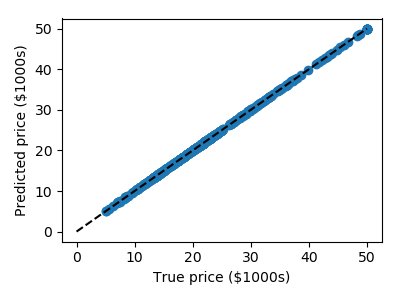
3.6.9.2. Demo PCA in 2D
Load the iris data
from sklearn import datasets
iris = datasets.load_iris()
X = iris.data
y = iris.target
Fit a PCA
from sklearn.decomposition import PCA
pca = PCA(n_components=2, whiten=True)
pca.fit(X)
Project the data in 2D
X_pca = pca.transform(X)
Visualize the data
target_ids = range(len(iris.target_names))
from matplotlib import pyplot as plt
plt.figure(figsize=(6, 5))
for i, c, label in zip(target_ids, 'rgbcmykw', iris.target_names):
plt.scatter(X_pca[y == i, 0], X_pca[y == i, 1],
c=c, label=label)
plt.legend()
plt.show()

3.6.9.3. A simple linear regression

import numpy as np
import matplotlib.pyplot as plt
from sklearn.linear_model import LinearRegression
# x from 0 to 30
x = 30 * np.random.random((20, 1))
# y = a*x + b with noise
y = 0.5 * x + 1.0 + np.random.normal(size=x.shape)
# create a linear regression model
model = LinearRegression()
model.fit(x, y)
# predict y from the data
x_new = np.linspace(0, 30, 100)
y_new = model.predict(x_new[:, np.newaxis])
# plot the results
plt.figure(figsize=(4, 3))
ax = plt.axes()
ax.scatter(x, y)
ax.plot(x_new, y_new)
ax.set_xlabel('x')
ax.set_ylabel('y')
ax.axis('tight')
plt.show()
3.6.9.4. Plot 2D views of the iris dataset
Plot a simple scatter plot of 2 features of the iris dataset.
Note that more elaborate visualization of this dataset is detailed in theStatistics in Python chapter.

# Load the data
from sklearn.datasets import load_iris
iris = load_iris()
from matplotlib import pyplot as plt
# The indices of the features that we are plotting
x_index = 0
y_index = 1
# this formatter will label the colorbar with the correct target names
formatter = plt.FuncFormatter(lambda i, *args: iris.target_names[int(i)])
plt.figure(figsize=(5, 4))
plt.scatter(iris.data[:, x_index], iris.data[:, y_index], c=iris.target)
plt.colorbar(ticks=[0, 1, 2], format=formatter)
plt.xlabel(iris.feature_names[x_index])
plt.ylabel(iris.feature_names[y_index])
plt.tight_layout()
plt.show()
3.6.9.5. tSNE to visualize digits
Here we use sklearn.manifold.TSNE to visualize the digits datasets. Indeed, the digits are vectors in a 8*8 = 64 dimensional space. We want to project them in 2D for visualization. tSNE is often a good solution, as it groups and separates data points based on their local relationship.
Load the iris data
from sklearn import datasets
digits = datasets.load_digits()
# Take the first 500 data points: it's hard to see 1500 points
X = digits.data[:500]
y = digits.target[:500]
Fit and transform with a TSNE
from sklearn.manifold import TSNE
tsne = TSNE(n_components=2, random_state=0)
Project the data in 2D
X_2d = tsne.fit_transform(X)
Visualize the data
target_ids = range(len(digits.target_names))
from matplotlib import pyplot as plt
plt.figure(figsize=(6, 5))
colors = 'r', 'g', 'b', 'c', 'm', 'y', 'k', 'w', 'orange', 'purple'
for i, c, label in zip(target_ids, colors, digits.target_names):
plt.scatter(X_2d[y == i, 0], X_2d[y == i, 1], c=c, label=label)
plt.legend()
plt.show()
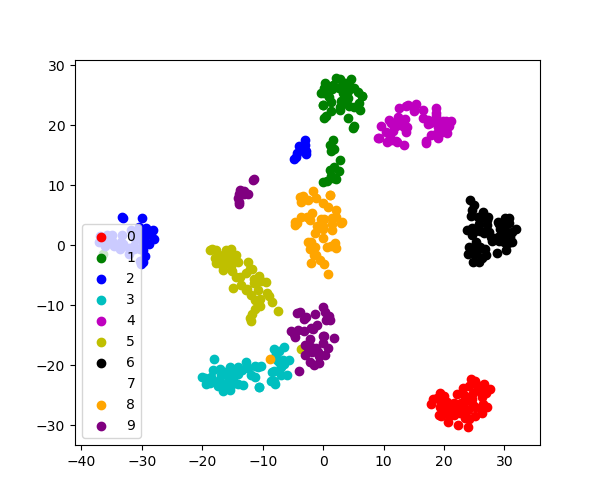
3.6.9.6. Use the RidgeCV and LassoCV to set the regularization parameter
Load the diabetes dataset
from sklearn.datasets import load_diabetes
data = load_diabetes()
X, y = data.data, data.target
print(X.shape)
Out:
(442, 10)
Compute the cross-validation score with the default hyper-parameters
from sklearn.model_selection import cross_val_score
from sklearn.linear_model import Ridge, Lasso
for Model in [Ridge, Lasso]:
model = Model()
print('%s: %s' % (Model.__name__,
cross_val_score(model, X, y).mean()))
Out:
Ridge: 0.409427438303
Lasso: 0.353800083299
We compute the cross-validation score as a function of alpha, the strength of the regularization for Lasso and Ridge
import numpy as np
from matplotlib import pyplot as plt
alphas = np.logspace(-3, -1, 30)
plt.figure(figsize=(5, 3))
for Model in [Lasso, Ridge]:
scores = [cross_val_score(Model(alpha), X, y, cv=3).mean()
for alpha in alphas]
plt.plot(alphas, scores, label=Model.__name__)
plt.legend(loc='lower left')
plt.xlabel('alpha')
plt.ylabel('cross validation score')
plt.tight_layout()
plt.show()
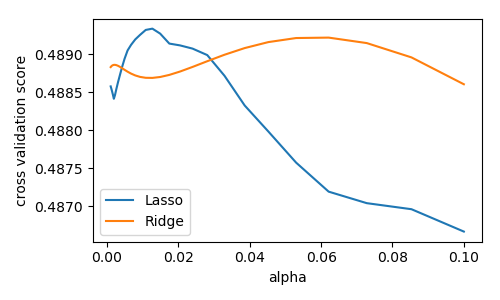
3.6.9.7. Plot variance and regularization in linear models
import numpy as np
# Smaller figures
from matplotlib import pyplot as plt
plt.rcParams['figure.figsize'] = (3, 2)
We consider the situation where we have only 2 data point
X = np.c_[ .5, 1].T
y = [.5, 1]
X_test = np.c_[ 0, 2].T
Without noise, as linear regression fits the data perfectly
from sklearn import linear_model
regr = linear_model.LinearRegression()
regr.fit(X, y)
plt.plot(X, y, 'o')
plt.plot(X_test, regr.predict(X_test))
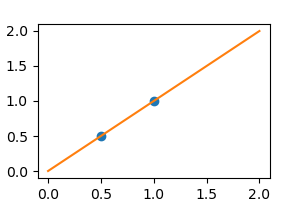
In real life situation, we have noise (e.g. measurement noise) in our data:
np.random.seed(0)
for _ in range(6):
noisy_X = X + np.random.normal(loc=0, scale=.1, size=X.shape)
plt.plot(noisy_X, y, 'o')
regr.fit(noisy_X, y)
plt.plot(X_test, regr.predict(X_test))
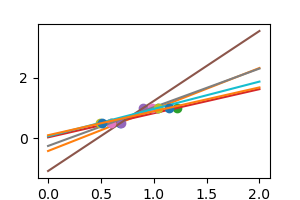
As we can see, our linear model captures and amplifies the noise in the data. It displays a lot of variance.
We can use another linear estimator that uses regularization, the Ridgeestimator. This estimator regularizes the coefficients by shrinking them to zero, under the assumption that very high correlations are often spurious. The alpha parameter controls the amount of shrinkage used.
regr = linear_model.Ridge(alpha=.1)
np.random.seed(0)
for _ in range(6):
noisy_X = X + np.random.normal(loc=0, scale=.1, size=X.shape)
plt.plot(noisy_X, y, 'o')
regr.fit(noisy_X, y)
plt.plot(X_test, regr.predict(X_test))
plt.show()
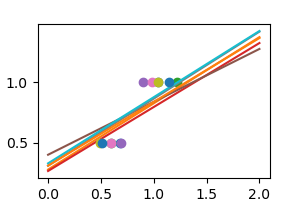
3.6.9.8. Simple picture of the formal problem of machine learning
This example generates simple synthetic data ploints and shows a separating hyperplane on them.
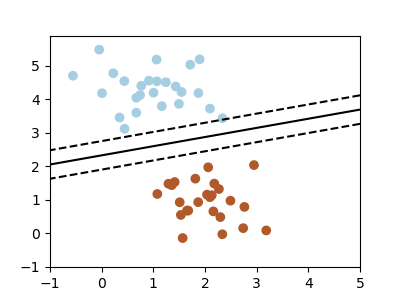
import numpy as np
import matplotlib.pyplot as plt
from sklearn.linear_model import SGDClassifier
from sklearn.datasets.samples_generator import make_blobs
# we create 50 separable synthetic points
X, Y = make_blobs(n_samples=50, centers=2,
random_state=0, cluster_std=0.60)
# fit the model
clf = SGDClassifier(loss="hinge", alpha=0.01,
n_iter=200, fit_intercept=True)
clf.fit(X, Y)
# plot the line, the points, and the nearest vectors to the plane
xx = np.linspace(-1, 5, 10)
yy = np.linspace(-1, 5, 10)
X1, X2 = np.meshgrid(xx, yy)
Z = np.empty(X1.shape)
for (i, j), val in np.ndenumerate(X1):
x1 = val
x2 = X2[i, j]
p = clf.decision_function([[x1, x2]])
Z[i, j] = p[0]
plt.figure(figsize=(4, 3))
ax = plt.axes()
ax.contour(X1, X2, Z, [-1.0, 0.0, 1.0], colors='k',
linestyles=['dashed', 'solid', 'dashed'])
ax.scatter(X[:, 0], X[:, 1], c=Y, cmap=plt.cm.Paired)
ax.axis('tight')
plt.show()
3.6.9.9. Compare classifiers on the digits data
Compare the performance of a variety of classifiers on a test set for the digits data.
Out:
LinearSVC: 0.927190026916
GaussianNB: 0.833274168101
KNeighborsClassifier: 0.980456280495
------------------
LinearSVC(loss='l1'): 0.9325901988044822
LinearSVC(loss='l2'): 0.9165874249889226
-------------------
KNeighbors(n_neighbors=1): 0.9913675218842191
KNeighbors(n_neighbors=2): 0.9848442068835102
KNeighbors(n_neighbors=3): 0.9867753449543099
KNeighbors(n_neighbors=4): 0.9803719053818863
KNeighbors(n_neighbors=5): 0.9804562804949924
KNeighbors(n_neighbors=6): 0.9757924194139573
KNeighbors(n_neighbors=7): 0.9780645792142071
KNeighbors(n_neighbors=8): 0.9780645792142071
KNeighbors(n_neighbors=9): 0.9780645792142071
KNeighbors(n_neighbors=10): 0.9755550897728812
from sklearn import model_selection, datasets, metrics
from sklearn.svm import LinearSVC
from sklearn.naive_bayes import GaussianNB
from sklearn.neighbors import KNeighborsClassifier
digits = datasets.load_digits()
X = digits.data
y = digits.target
X_train, X_test, y_train, y_test = model_selection.train_test_split(X, y,
test_size=0.25, random_state=0)
for Model in [LinearSVC, GaussianNB, KNeighborsClassifier]:
clf = Model().fit(X_train, y_train)
y_pred = clf.predict(X_test)
print('%s: %s' %
(Model.__name__, metrics.f1_score(y_test, y_pred, average="macro")))
print('------------------')
# test SVC loss
for loss in ['l1', 'l2']:
clf = LinearSVC(loss=loss).fit(X_train, y_train)
y_pred = clf.predict(X_test)
print("LinearSVC(loss='{0}'): {1}".format(loss,
metrics.f1_score(y_test, y_pred, average="macro")))
print('-------------------')
# test the number of neighbors
for n_neighbors in range(1, 11):
clf = KNeighborsClassifier(n_neighbors=n_neighbors).fit(X_train, y_train)
y_pred = clf.predict(X_test)
print("KNeighbors(n_neighbors={0}): {1}".format(n_neighbors,
metrics.f1_score(y_test, y_pred, average="macro")))
3.6.9.10. Plot fitting a 9th order polynomial
Fits data generated from a 9th order polynomial with model of 4th order and 9th order polynomials, to demonstrate that often simpler models are to be prefered
import numpy as np
from matplotlib import pyplot as plt
from matplotlib.colors import ListedColormap
from sklearn import linear_model
# Create color maps for 3-class classification problem, as with iris
cmap_light = ListedColormap(['#FFAAAA', '#AAFFAA', '#AAAAFF'])
cmap_bold = ListedColormap(['#FF0000', '#00FF00', '#0000FF'])
rng = np.random.RandomState(0)
x = 2*rng.rand(100) - 1
f = lambda t: 1.2 * t**2 + .1 * t**3 - .4 * t **5 - .5 * t ** 9
y = f(x) + .4 * rng.normal(size=100)
x_test = np.linspace(-1, 1, 100)
The data
plt.figure(figsize=(6, 4))
plt.scatter(x, y, s=4)
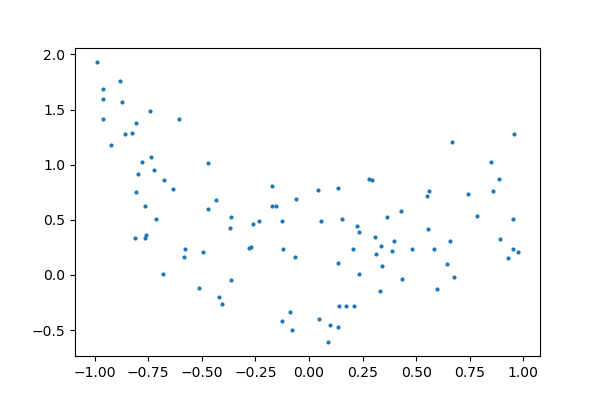
Fitting 4th and 9th order polynomials
For this we need to engineer features: the n_th powers of x:
plt.figure(figsize=(6, 4))
plt.scatter(x, y, s=4)
X = np.array([x**i for i in range(5)]).T
X_test = np.array([x_test**i for i in range(5)]).T
regr = linear_model.LinearRegression()
regr.fit(X, y)
plt.plot(x_test, regr.predict(X_test), label='4th order')
X = np.array([x**i for i in range(10)]).T
X_test = np.array([x_test**i for i in range(10)]).T
regr = linear_model.LinearRegression()
regr.fit(X, y)
plt.plot(x_test, regr.predict(X_test), label='9th order')
plt.legend(loc='best')
plt.axis('tight')
plt.title('Fitting a 4th and a 9th order polynomial')
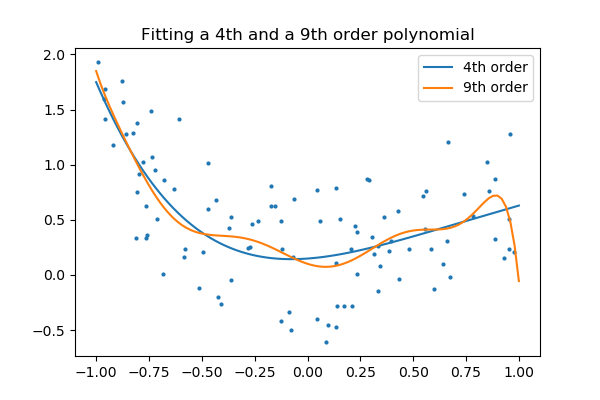
Ground truth
plt.figure(figsize=(6, 4))
plt.scatter(x, y, s=4)
plt.plot(x_test, f(x_test), label="truth")
plt.axis('tight')
plt.title('Ground truth (9th order polynomial)')
plt.show()
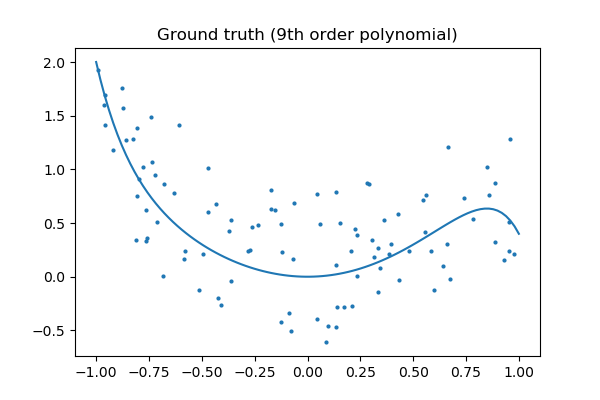
3.6.9.11. A simple regression analysis on the Boston housing data
Here we perform a simple regression analysis on the Boston housing data, exploring two types of regressors.
from sklearn.datasets import load_boston
data = load_boston()
Print a histogram of the quantity to predict: price
import matplotlib.pyplot as plt
plt.figure(figsize=(4, 3))
plt.hist(data.target)
plt.xlabel('price ($1000s)')
plt.ylabel('count')
plt.tight_layout()

Print the join histogram for each feature
for index, feature_name in enumerate(data.feature_names):
plt.figure(figsize=(4, 3))
plt.scatter(data.data[:, index], data.target)
plt.ylabel('Price', size=15)
plt.xlabel(feature_name, size=15)
plt.tight_layout()
Simple prediction
from sklearn.model_selection import train_test_split
X_train, X_test, y_train, y_test = train_test_split(data.data, data.target)
from sklearn.linear_model import LinearRegression
clf = LinearRegression()
clf.fit(X_train, y_train)
predicted = clf.predict(X_test)
expected = y_test
plt.figure(figsize=(4, 3))
plt.scatter(expected, predicted)
plt.plot([0, 50], [0, 50], '--k')
plt.axis('tight')
plt.xlabel('True price ($1000s)')
plt.ylabel('Predicted price ($1000s)')
plt.tight_layout()

Prediction with gradient boosted tree
from sklearn.ensemble import GradientBoostingRegressor
clf = GradientBoostingRegressor()
clf.fit(X_train, y_train)
predicted = clf.predict(X_test)
expected = y_test
plt.figure(figsize=(4, 3))
plt.scatter(expected, predicted)
plt.plot([0, 50], [0, 50], '--k')
plt.axis('tight')
plt.xlabel('True price ($1000s)')
plt.ylabel('Predicted price ($1000s)')
plt.tight_layout()

Print the error rate
import numpy as np
print("RMS: %r " % np.sqrt(np.mean((predicted - expected) ** 2)))
plt.show()
Out:
RMS: 3.3940265988986305
3.6.9.12. Nearest-neighbor prediction on iris
Plot the decision boundary of nearest neighbor decision on iris, first with a single nearest neighbor, and then using 3 nearest neighbors.
import numpy as np
from matplotlib import pyplot as plt
from sklearn import neighbors, datasets
from matplotlib.colors import ListedColormap
# Create color maps for 3-class classification problem, as with iris
cmap_light = ListedColormap(['#FFAAAA', '#AAFFAA', '#AAAAFF'])
cmap_bold = ListedColormap(['#FF0000', '#00FF00', '#0000FF'])
iris = datasets.load_iris()
X = iris.data[:, :2] # we only take the first two features. We could
# avoid this ugly slicing by using a two-dim dataset
y = iris.target
knn = neighbors.KNeighborsClassifier(n_neighbors=1)
knn.fit(X, y)
x_min, x_max = X[:, 0].min() - .1, X[:, 0].max() + .1
y_min, y_max = X[:, 1].min() - .1, X[:, 1].max() + .1
xx, yy = np.meshgrid(np.linspace(x_min, x_max, 100),
np.linspace(y_min, y_max, 100))
Z = knn.predict(np.c_[xx.ravel(), yy.ravel()])
Put the result into a color plot
Z = Z.reshape(xx.shape)
plt.figure()
plt.pcolormesh(xx, yy, Z, cmap=cmap_light)
# Plot also the training points
plt.scatter(X[:, 0], X[:, 1], c=y, cmap=cmap_bold)
plt.xlabel('sepal length (cm)')
plt.ylabel('sepal width (cm)')
plt.axis('tight')
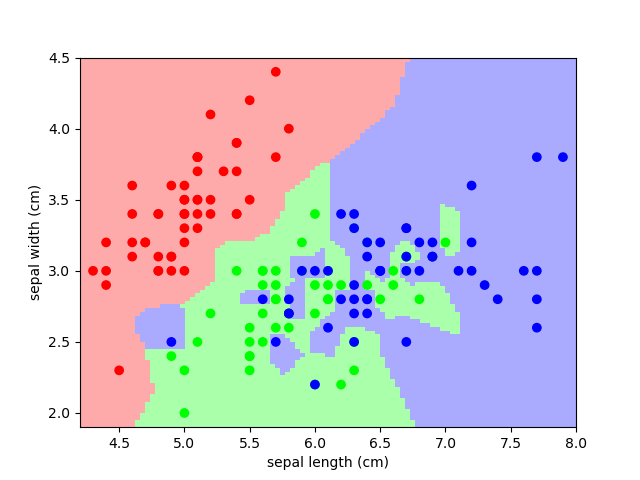
And now, redo the analysis with 3 neighbors
knn = neighbors.KNeighborsClassifier(n_neighbors=3)
knn.fit(X, y)
Z = knn.predict(np.c_[xx.ravel(), yy.ravel()])
# Put the result into a color plot
Z = Z.reshape(xx.shape)
plt.figure()
plt.pcolormesh(xx, yy, Z, cmap=cmap_light)
# Plot also the training points
plt.scatter(X[:, 0], X[:, 1], c=y, cmap=cmap_bold)
plt.xlabel('sepal length (cm)')
plt.ylabel('sepal width (cm)')
plt.axis('tight')
plt.show()
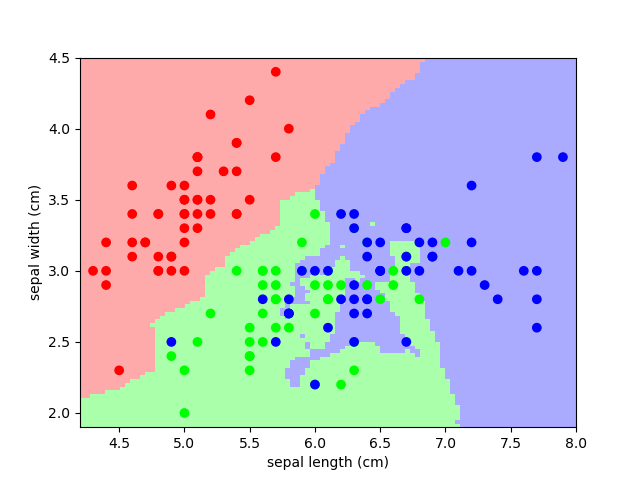
3.6.9.13. Simple visualization and classification of the digits dataset
Plot the first few samples of the digits dataset and a 2D representation built using PCA, then do a simple classification
from sklearn.datasets import load_digits
digits = load_digits()
Plot the data: images of digits
Each data in a 8x8 image
from matplotlib import pyplot as plt
fig = plt.figure(figsize=(6, 6)) # figure size in inches
fig.subplots_adjust(left=0, right=1, bottom=0, top=1, hspace=0.05, wspace=0.05)
for i in range(64):
ax = fig.add_subplot(8, 8, i + 1, xticks=[], yticks=[])
ax.imshow(digits.images[i], cmap=plt.cm.binary, interpolation='nearest')
# label the image with the target value
ax.text(0, 7, str(digits.target[i]))
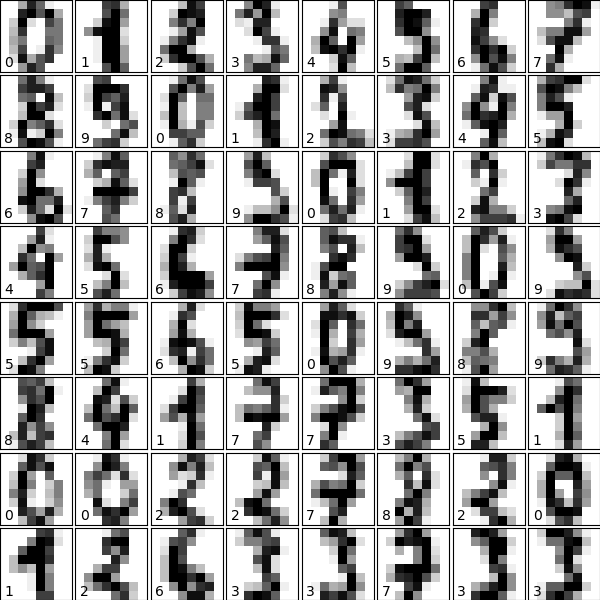
Plot a projection on the 2 first principal axis
plt.figure()
from sklearn.decomposition import PCA
pca = PCA(n_components=2)
proj = pca.fit_transform(digits.data)
plt.scatter(proj[:, 0], proj[:, 1], c=digits.target)
plt.colorbar()
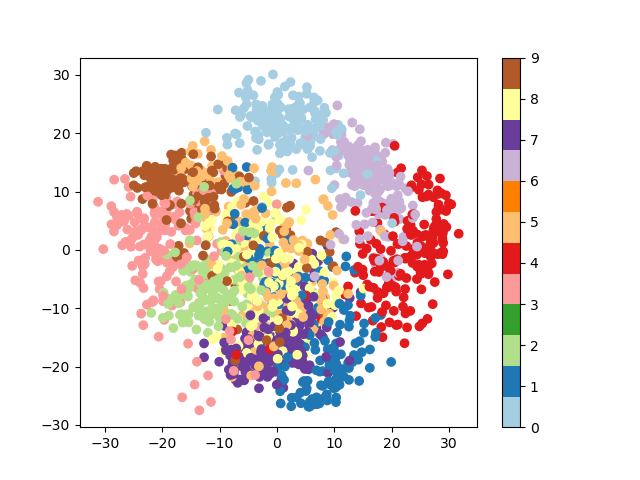
Classify with Gaussian naive Bayes
from sklearn.naive_bayes import GaussianNB
from sklearn.model_selection import train_test_split
# split the data into training and validation sets
X_train, X_test, y_train, y_test = train_test_split(digits.data, digits.target)
# train the model
clf = GaussianNB()
clf.fit(X_train, y_train)
# use the model to predict the labels of the test data
predicted = clf.predict(X_test)
expected = y_test
# Plot the prediction
fig = plt.figure(figsize=(6, 6)) # figure size in inches
fig.subplots_adjust(left=0, right=1, bottom=0, top=1, hspace=0.05, wspace=0.05)
# plot the digits: each image is 8x8 pixels
for i in range(64):
ax = fig.add_subplot(8, 8, i + 1, xticks=[], yticks=[])
ax.imshow(X_test.reshape(-1, 8, 8)[i], cmap=plt.cm.binary,
interpolation='nearest')
# label the image with the target value
if predicted[i] == expected[i]:
ax.text(0, 7, str(predicted[i]), color='green')
else:
ax.text(0, 7, str(predicted[i]), color='red')
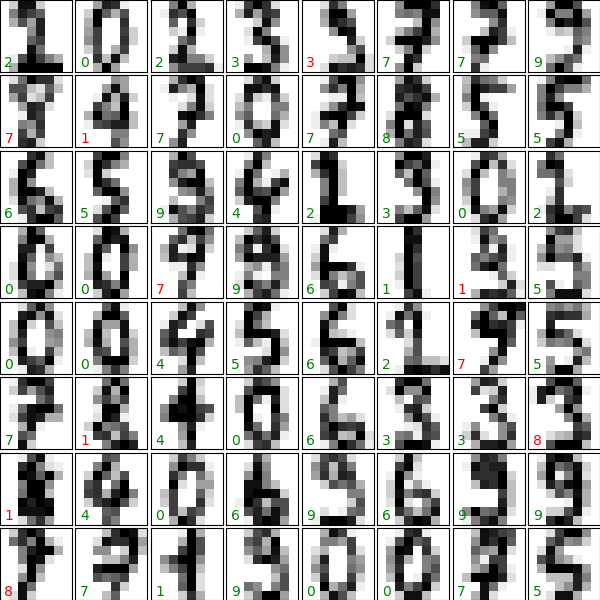
Quantify the performance
First print the number of correct matches
matches = (predicted == expected)
print(matches.sum())
Out:
384
The total number of data points
print(len(matches))
Out:
450
And now, the ration of correct predictions
matches.sum() / float(len(matches))
Print the classification report
from sklearn import metrics
print(metrics.classification_report(expected, predicted))
Out:
precision recall f1-score support
0 1.00 0.93 0.96 40
1 0.82 0.85 0.84 48
2 0.91 0.69 0.78 45
3 0.96 0.83 0.89 58
4 0.91 0.89 0.90 36
5 0.91 0.85 0.88 48
6 0.93 0.98 0.95 43
7 0.75 0.98 0.85 47
8 0.59 0.81 0.68 42
9 0.91 0.74 0.82 43
avg / total 0.87 0.85 0.86 450
Print the confusion matrix
print(metrics.confusion_matrix(expected, predicted))
plt.show()
Out:
[[37 0 0 0 2 0 0 1 0 0]
[ 0 41 0 0 0 0 1 0 4 2]
[ 0 2 31 0 0 0 1 0 11 0]
[ 0 0 2 48 0 1 0 2 4 1]
[ 0 1 1 0 32 0 0 1 1 0]
[ 0 1 0 1 1 41 0 4 0 0]
[ 0 0 0 0 0 1 42 0 0 0]
[ 0 0 0 0 0 1 0 46 0 0]
[ 0 4 0 0 0 1 0 3 34 0]
[ 0 1 0 1 0 0 1 4 4 32]]
3.6.9.14. The eigenfaces example: chaining PCA and SVMs
The goal of this example is to show how an unsupervised method and a supervised one can be chained for better prediction. It starts with a didactic but lengthy way of doing things, and finishes with the idiomatic approach to pipelining in scikit-learn.
Here we’ll take a look at a simple facial recognition example. Ideally, we would use a dataset consisting of a subset of the Labeled Faces in the Wilddata that is available with sklearn.datasets.fetch_lfw_people(). However, this is a relatively large download (~200MB) so we will do the tutorial on a simpler, less rich dataset. Feel free to explore the LFW dataset.
from sklearn import datasets
faces = datasets.fetch_olivetti_faces()
faces.data.shape
Let’s visualize these faces to see what we’re working with
from matplotlib import pyplot as plt
fig = plt.figure(figsize=(8, 6))
# plot several images
for i in range(15):
ax = fig.add_subplot(3, 5, i + 1, xticks=[], yticks=[])
ax.imshow(faces.images[i], cmap=plt.cm.bone)
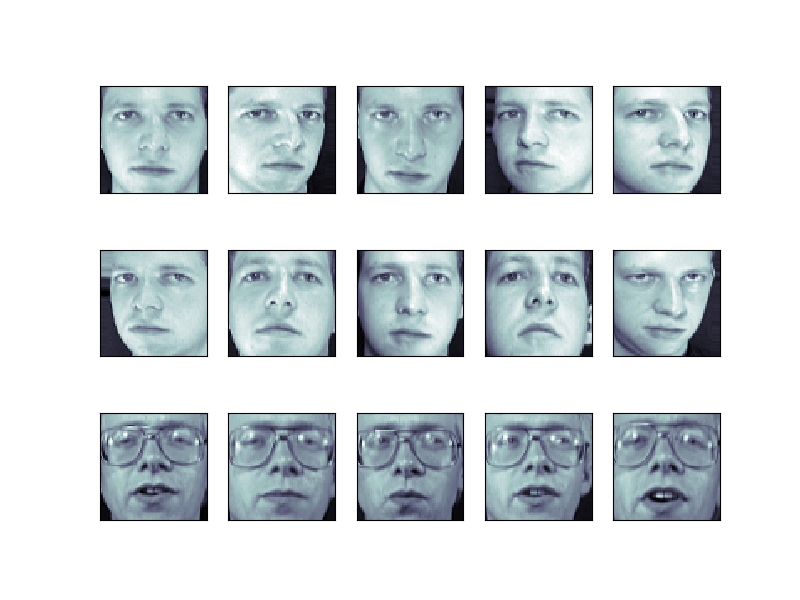
Note is that these faces have already been localized and scaled to a common size. This is an important preprocessing piece for facial recognition, and is a process that can require a large collection of training data. This can be done in scikit-learn, but the challenge is gathering a sufficient amount of training data for the algorithm to work. Fortunately, this piece is common enough that it has been done. One good resource is OpenCV, the Open Computer Vision Library.
We’ll perform a Support Vector classification of the images. We’ll do a typical train-test split on the images:
from sklearn.model_selection import train_test_split
X_train, X_test, y_train, y_test = train_test_split(faces.data,
faces.target, random_state=0)
print(X_train.shape, X_test.shape)
Out:
(300, 4096) (100, 4096)
Preprocessing: Principal Component Analysis
1850 dimensions is a lot for SVM. We can use PCA to reduce these 1850 features to a manageable size, while maintaining most of the information in the dataset.
from sklearn import decomposition
pca = decomposition.PCA(n_components=150, whiten=True)
pca.fit(X_train)
One interesting part of PCA is that it computes the “mean” face, which can be interesting to examine:
plt.imshow(pca.mean_.reshape(faces.images[0].shape),
cmap=plt.cm.bone)
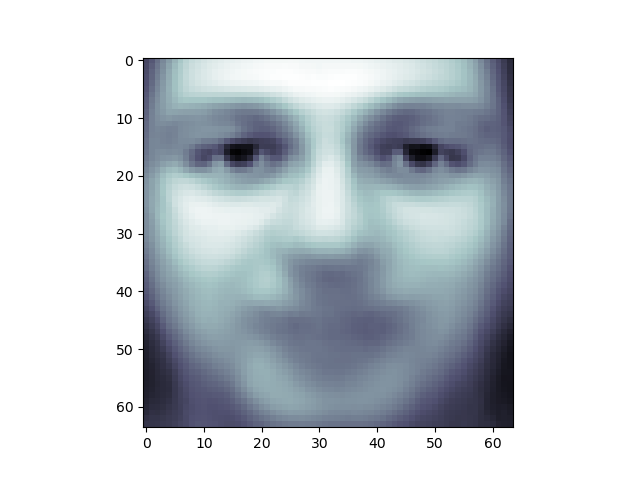
The principal components measure deviations about this mean along orthogonal axes.
print(pca.components_.shape)
Out:
(150, 4096)
It is also interesting to visualize these principal components:
fig = plt.figure(figsize=(16, 6))
for i in range(30):
ax = fig.add_subplot(3, 10, i + 1, xticks=[], yticks=[])
ax.imshow(pca.components_[i].reshape(faces.images[0].shape),
cmap=plt.cm.bone)
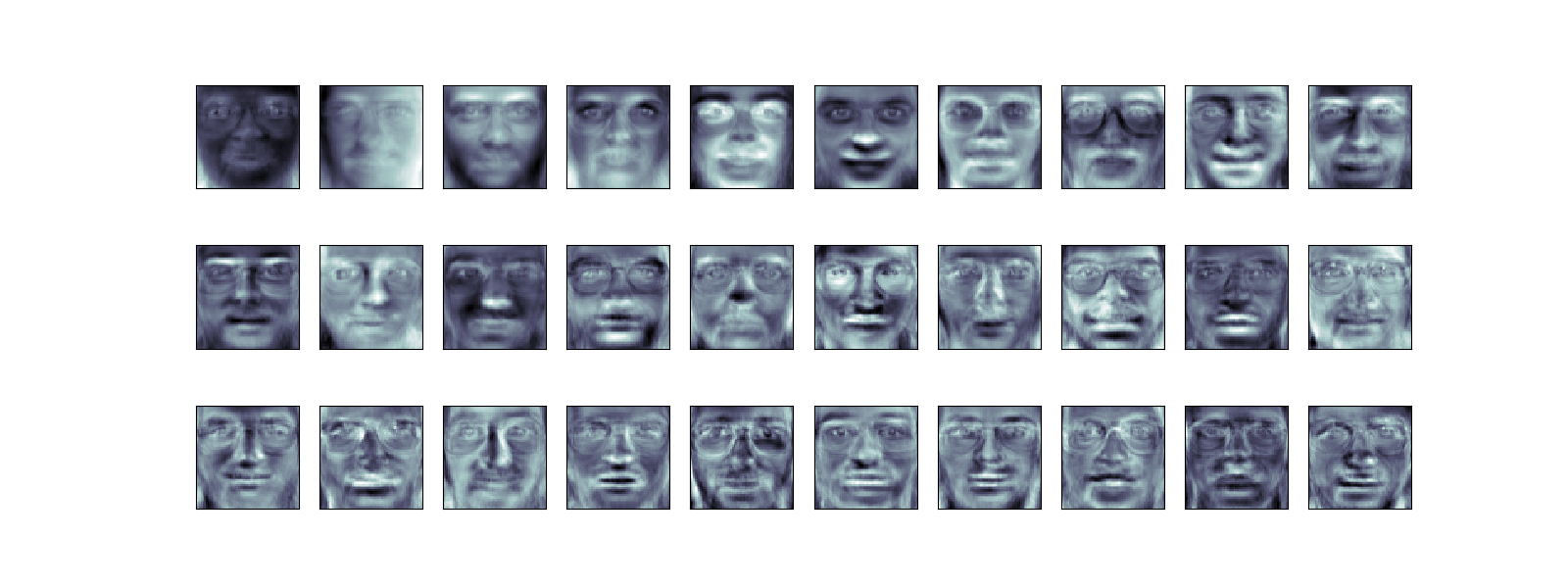
The components (“eigenfaces”) are ordered by their importance from top-left to bottom-right. We see that the first few components seem to primarily take care of lighting conditions; the remaining components pull out certain identifying features: the nose, eyes, eyebrows, etc.
With this projection computed, we can now project our original training and test data onto the PCA basis:
X_train_pca = pca.transform(X_train)
X_test_pca = pca.transform(X_test)
print(X_train_pca.shape)
Out:
(300, 150)
print(X_test_pca.shape)
Out:
(100, 150)
These projected components correspond to factors in a linear combination of component images such that the combination approaches the original face.
Doing the Learning: Support Vector Machines
Now we’ll perform support-vector-machine classification on this reduced dataset:
from sklearn import svm
clf = svm.SVC(C=5., gamma=0.001)
clf.fit(X_train_pca, y_train)
Finally, we can evaluate how well this classification did. First, we might plot a few of the test-cases with the labels learned from the training set:
import numpy as np
fig = plt.figure(figsize=(8, 6))
for i in range(15):
ax = fig.add_subplot(3, 5, i + 1, xticks=[], yticks=[])
ax.imshow(X_test[i].reshape(faces.images[0].shape),
cmap=plt.cm.bone)
y_pred = clf.predict(X_test_pca[i, np.newaxis])[0]
color = ('black' if y_pred == y_test[i] else 'red')
ax.set_title(faces.target[y_pred],
fontsize='small', color=color)

The classifier is correct on an impressive number of images given the simplicity of its learning model! Using a linear classifier on 150 features derived from the pixel-level data, the algorithm correctly identifies a large number of the people in the images.
Again, we can quantify this effectiveness using one of several measures fromsklearn.metrics. First we can do the classification report, which shows the precision, recall and other measures of the “goodness” of the classification:
from sklearn import metrics
y_pred = clf.predict(X_test_pca)
print(metrics.classification_report(y_test, y_pred))
Out:
precision recall f1-score support
0 1.00 0.67 0.80 6
1 1.00 1.00 1.00 4
2 0.50 1.00 0.67 2
3 1.00 1.00 1.00 1
4 1.00 1.00 1.00 1
5 1.00 1.00 1.00 5
6 1.00 1.00 1.00 4
7 1.00 0.67 0.80 3
9 1.00 1.00 1.00 1
10 1.00 1.00 1.00 4
11 1.00 1.00 1.00 1
12 0.67 1.00 0.80 2
13 1.00 1.00 1.00 3
14 1.00 1.00 1.00 5
15 1.00 1.00 1.00 3
17 1.00 1.00 1.00 6
19 1.00 1.00 1.00 4
20 1.00 1.00 1.00 1
21 1.00 1.00 1.00 1
22 1.00 1.00 1.00 2
23 0.50 1.00 0.67 1
24 1.00 1.00 1.00 2
25 1.00 0.50 0.67 2
26 1.00 0.75 0.86 4
27 1.00 1.00 1.00 1
28 0.67 1.00 0.80 2
29 1.00 1.00 1.00 3
30 1.00 1.00 1.00 4
31 1.00 1.00 1.00 3
32 1.00 1.00 1.00 3
33 1.00 1.00 1.00 2
34 1.00 1.00 1.00 3
35 1.00 1.00 1.00 1
36 1.00 1.00 1.00 3
37 1.00 1.00 1.00 3
38 1.00 1.00 1.00 1
39 1.00 1.00 1.00 3
avg / total 0.97 0.95 0.95 100
Another interesting metric is the confusion matrix, which indicates how often any two items are mixed-up. The confusion matrix of a perfect classifier would only have nonzero entries on the diagonal, with zeros on the off-diagonal:
print(metrics.confusion_matrix(y_test, y_pred))
Out:
[[4 0 0 ..., 0 0 0]
[0 4 0 ..., 0 0 0]
[0 0 2 ..., 0 0 0]
...,
[0 0 0 ..., 3 0 0]
[0 0 0 ..., 0 1 0]
[0 0 0 ..., 0 0 3]]
Pipelining
Above we used PCA as a pre-processing step before applying our support vector machine classifier. Plugging the output of one estimator directly into the input of a second estimator is a commonly used pattern; for this reason scikit-learn provides a Pipeline object which automates this process. The above problem can be re-expressed as a pipeline as follows:
from sklearn.pipeline import Pipeline
clf = Pipeline([('pca', decomposition.PCA(n_components=150, whiten=True)),
('svm', svm.LinearSVC(C=1.0))])
clf.fit(X_train, y_train)
y_pred = clf.predict(X_test)
print(metrics.confusion_matrix(y_pred, y_test))
plt.show()
Out:
[[5 0 0 ..., 0 0 0]
[0 4 0 ..., 0 0 0]
[0 0 1 ..., 0 0 0]
...,
[0 0 0 ..., 3 0 0]
[0 0 0 ..., 0 1 0]
[0 0 0 ..., 0 0 3]]
3.6.9.15. Example of linear and non-linear models
This is an example plot from the tutorial which accompanies an explanation of the support vector machine GUI.
import numpy as np
from matplotlib import pyplot as plt
from sklearn import svm
data that is linearly separable
def linear_model(rseed=42, n_samples=30):
" Generate data according to a linear model"
np.random.seed(rseed)
data = np.random.normal(0, 10, (n_samples, 2))
data[:n_samples // 2] -= 15
data[n_samples // 2:] += 15
labels = np.ones(n_samples)
labels[:n_samples // 2] = -1
return data, labels
X, y = linear_model()
clf = svm.SVC(kernel='linear')
clf.fit(X, y)
plt.figure(figsize=(6, 4))
ax = plt.subplot(111, xticks=[], yticks=[])
ax.scatter(X[:, 0], X[:, 1], c=y, cmap=plt.cm.bone)
ax.scatter(clf.support_vectors_[:, 0],
clf.support_vectors_[:, 1],
s=80, edgecolors="k", facecolors="none")
delta = 1
y_min, y_max = -50, 50
x_min, x_max = -50, 50
x = np.arange(x_min, x_max + delta, delta)
y = np.arange(y_min, y_max + delta, delta)
X1, X2 = np.meshgrid(x, y)
Z = clf.decision_function(np.c_[X1.ravel(), X2.ravel()])
Z = Z.reshape(X1.shape)
ax.contour(X1, X2, Z, [-1.0, 0.0, 1.0], colors='k',
linestyles=['dashed', 'solid', 'dashed'])
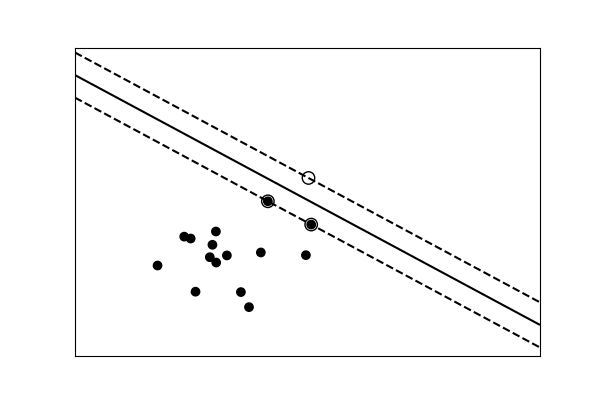
data with a non-linear separation
def nonlinear_model(rseed=42, n_samples=30):
radius = 40 * np.random.random(n_samples)
far_pts = radius > 20
radius[far_pts] *= 1.2
radius[~far_pts] *= 1.1
theta = np.random.random(n_samples) * np.pi * 2
data = np.empty((n_samples, 2))
data[:, 0] = radius * np.cos(theta)
data[:, 1] = radius * np.sin(theta)
labels = np.ones(n_samples)
labels[far_pts] = -1
return data, labels
X, y = nonlinear_model()
clf = svm.SVC(kernel='rbf', gamma=0.001, coef0=0, degree=3)
clf.fit(X, y)
plt.figure(figsize=(6, 4))
ax = plt.subplot(1, 1, 1, xticks=[], yticks=[])
ax.scatter(X[:, 0], X[:, 1], c=y, cmap=plt.cm.bone, zorder=2)
ax.scatter(clf.support_vectors_[:, 0], clf.support_vectors_[:, 1],
s=80, edgecolors="k", facecolors="none")
delta = 1
y_min, y_max = -50, 50
x_min, x_max = -50, 50
x = np.arange(x_min, x_max + delta, delta)
y = np.arange(y_min, y_max + delta, delta)
X1, X2 = np.meshgrid(x, y)
Z = clf.decision_function(np.c_[X1.ravel(), X2.ravel()])
Z = Z.reshape(X1.shape)
ax.contour(X1, X2, Z, [-1.0, 0.0, 1.0], colors='k',
linestyles=['dashed', 'solid', 'dashed'], zorder=1)
plt.show()
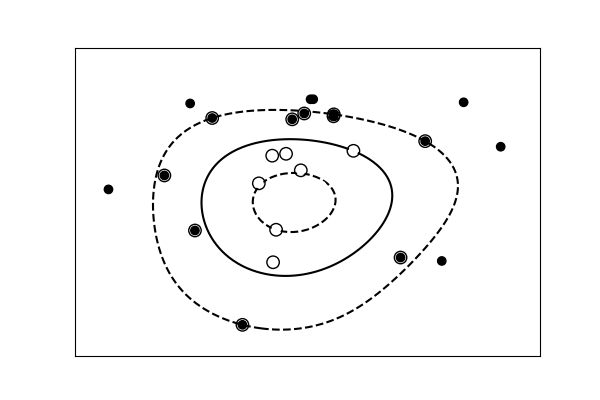
3.6.9.16. Bias and variance of polynomial fit
Demo overfitting, underfitting, and validation and learning curves with polynomial regression.
Fit polynomes of different degrees to a dataset: for too small a degree, the model underfits, while for too large a degree, it overfits.
import numpy as np
import matplotlib.pyplot as plt
def generating_func(x, err=0.5):
return np.random.normal(10 - 1. / (x + 0.1), err)
A polynomial regression
from sklearn.pipeline import make_pipeline
from sklearn.linear_model import LinearRegression
from sklearn.preprocessing import PolynomialFeatures
A simple figure to illustrate the problem
n_samples = 8
np.random.seed(0)
x = 10 ** np.linspace(-2, 0, n_samples)
y = generating_func(x)
x_test = np.linspace(-0.2, 1.2, 1000)
titles = ['d = 1 (under-fit; high bias)',
'd = 2',
'd = 6 (over-fit; high variance)']
degrees = [1, 2, 6]
fig = plt.figure(figsize=(9, 3.5))
fig.subplots_adjust(left=0.06, right=0.98, bottom=0.15, top=0.85, wspace=0.05)
for i, d in enumerate(degrees):
ax = fig.add_subplot(131 + i, xticks=[], yticks=[])
ax.scatter(x, y, marker='x', c='k', s=50)
model = make_pipeline(PolynomialFeatures(d), LinearRegression())
model.fit(x[:, np.newaxis], y)
ax.plot(x_test, model.predict(x_test[:, np.newaxis]), '-b')
ax.set_xlim(-0.2, 1.2)
ax.set_ylim(0, 12)
ax.set_xlabel('house size')
if i == 0:
ax.set_ylabel('price')
ax.set_title(titles[i])
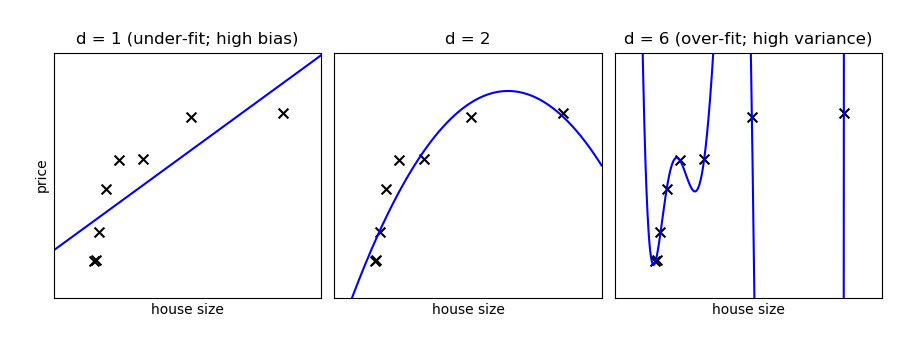
Generate a larger dataset
from sklearn.model_selection import train_test_split
n_samples = 200
test_size = 0.4
error = 1.0
# randomly sample the data
np.random.seed(1)
x = np.random.random(n_samples)
y = generating_func(x, error)
# split into training, validation, and testing sets.
x_train, x_test, y_train, y_test = train_test_split(x, y, test_size=test_size)
# show the training and validation sets
plt.figure(figsize=(6, 4))
plt.scatter(x_train, y_train, color='red', label='Training set')
plt.scatter(x_test, y_test, color='blue', label='Test set')
plt.title('The data')
plt.legend(loc='best')
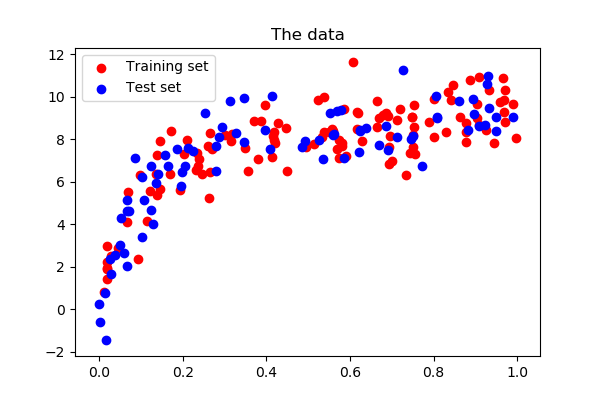
Plot a validation curve
from sklearn.model_selection import validation_curve
degrees = np.arange(1, 21)
model = make_pipeline(PolynomialFeatures(), LinearRegression())
# The parameter to vary is the "degrees" on the pipeline step
# "polynomialfeatures"
train_scores, validation_scores = validation_curve(
model, x[:, np.newaxis], y,
param_name='polynomialfeatures__degree',
param_range=degrees)
# Plot the mean train error and validation error across folds
plt.figure(figsize=(6, 4))
plt.plot(degrees, validation_scores.mean(axis=1), lw=2,
label='cross-validation')
plt.plot(degrees, train_scores.mean(axis=1), lw=2, label='training')
plt.legend(loc='best')
plt.xlabel('degree of fit')
plt.ylabel('explained variance')
plt.title('Validation curve')
plt.tight_layout()
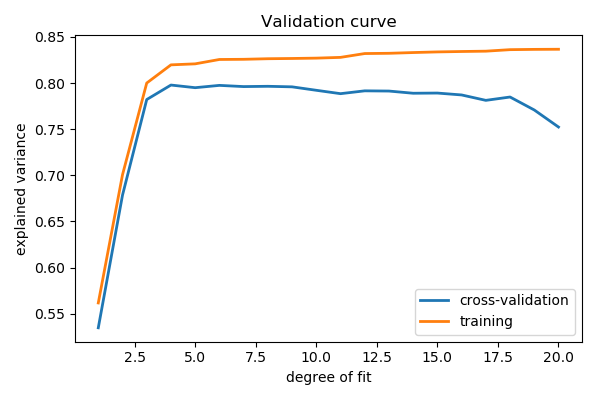
Learning curves
Plot train and test error with an increasing number of samples
# A learning curve for d=1, 5, 15
for d in [1, 5, 15]:
model = make_pipeline(PolynomialFeatures(degree=d), LinearRegression())
from sklearn.model_selection import learning_curve
train_sizes, train_scores, validation_scores = learning_curve(
model, x[:, np.newaxis], y,
train_sizes=np.logspace(-1, 0, 20))
# Plot the mean train error and validation error across folds
plt.figure(figsize=(6, 4))
plt.plot(train_sizes, validation_scores.mean(axis=1),
lw=2, label='cross-validation')
plt.plot(train_sizes, train_scores.mean(axis=1),
lw=2, label='training')
plt.ylim(ymin=-.1, ymax=1)
plt.legend(loc='best')
plt.xlabel('number of train samples')
plt.ylabel('explained variance')
plt.title('Learning curve (degree=%i)' % d)
plt.tight_layout()
plt.show()
3.6.9.17. Tutorial Diagrams
This script plots the flow-charts used in the scikit-learn tutorials.
import numpy as np
import pylab as pl
from matplotlib.patches import Circle, Rectangle, Polygon, Arrow, FancyArrow
def create_base(box_bg = '#CCCCCC',
arrow1 = '#88CCFF',
arrow2 = '#88FF88',
supervised=True):
fig = pl.figure(figsize=(9, 6), facecolor='w')
ax = pl.axes((0, 0, 1, 1),
xticks=[], yticks=[], frameon=False)
ax.set_xlim(0, 9)
ax.set_ylim(0, 6)
patches = [Rectangle((0.3, 3.6), 1.5, 1.8, zorder=1, fc=box_bg),
Rectangle((0.5, 3.8), 1.5, 1.8, zorder=2, fc=box_bg),
Rectangle((0.7, 4.0), 1.5, 1.8, zorder=3, fc=box_bg),
Rectangle((2.9, 3.6), 0.2, 1.8, fc=box_bg),
Rectangle((3.1, 3.8), 0.2, 1.8, fc=box_bg),
Rectangle((3.3, 4.0), 0.2, 1.8, fc=box_bg),
Rectangle((0.3, 0.2), 1.5, 1.8, fc=box_bg),
Rectangle((2.9, 0.2), 0.2, 1.8, fc=box_bg),
Circle((5.5, 3.5), 1.0, fc=box_bg),
Polygon([[5.5, 1.7],
[6.1, 1.1],
[5.5, 0.5],
[4.9, 1.1]], fc=box_bg),
FancyArrow(2.3, 4.6, 0.35, 0, fc=arrow1,
width=0.25, head_width=0.5, head_length=0.2),
FancyArrow(3.75, 4.2, 0.5, -0.2, fc=arrow1,
width=0.25, head_width=0.5, head_length=0.2),
FancyArrow(5.5, 2.4, 0, -0.4, fc=arrow1,
width=0.25, head_width=0.5, head_length=0.2),
FancyArrow(2.0, 1.1, 0.5, 0, fc=arrow2,
width=0.25, head_width=0.5, head_length=0.2),
FancyArrow(3.3, 1.1, 1.3, 0, fc=arrow2,
width=0.25, head_width=0.5, head_length=0.2),
FancyArrow(6.2, 1.1, 0.8, 0, fc=arrow2,
width=0.25, head_width=0.5, head_length=0.2)]
if supervised:
patches += [Rectangle((0.3, 2.4), 1.5, 0.5, zorder=1, fc=box_bg),
Rectangle((0.5, 2.6), 1.5, 0.5, zorder=2, fc=box_bg),
Rectangle((0.7, 2.8), 1.5, 0.5, zorder=3, fc=box_bg),
FancyArrow(2.3, 2.9, 2.0, 0, fc=arrow1,
width=0.25, head_width=0.5, head_length=0.2),
Rectangle((7.3, 0.85), 1.5, 0.5, fc=box_bg)]
else:
patches += [Rectangle((7.3, 0.2), 1.5, 1.8, fc=box_bg)]
for p in patches:
ax.add_patch(p)
pl.text(1.45, 4.9, "Training\nText,\nDocuments,\nImages,\netc.",
ha='center', va='center', fontsize=14)
pl.text(3.6, 4.9, "Feature\nVectors",
ha='left', va='center', fontsize=14)
pl.text(5.5, 3.5, "Machine\nLearning\nAlgorithm",
ha='center', va='center', fontsize=14)
pl.text(1.05, 1.1, "New Text,\nDocument,\nImage,\netc.",
ha='center', va='center', fontsize=14)
pl.text(3.3, 1.7, "Feature\nVector",
ha='left', va='center', fontsize=14)
pl.text(5.5, 1.1, "Predictive\nModel",
ha='center', va='center', fontsize=12)
if supervised:
pl.text(1.45, 3.05, "Labels",
ha='center', va='center', fontsize=14)
pl.text(8.05, 1.1, "Expected\nLabel",
ha='center', va='center', fontsize=14)
pl.text(8.8, 5.8, "Supervised Learning Model",
ha='right', va='top', fontsize=18)
else:
pl.text(8.05, 1.1,
"Likelihood\nor Cluster ID\nor Better\nRepresentation",
ha='center', va='center', fontsize=12)
pl.text(8.8, 5.8, "Unsupervised Learning Model",
ha='right', va='top', fontsize=18)
def plot_supervised_chart(annotate=False):
create_base(supervised=True)
if annotate:
fontdict = dict(color='r', weight='bold', size=14)
pl.text(1.9, 4.55, 'X = vec.fit_transform(input)',
fontdict=fontdict,
rotation=20, ha='left', va='bottom')
pl.text(3.7, 3.2, 'clf.fit(X, y)',
fontdict=fontdict,
rotation=20, ha='left', va='bottom')
pl.text(1.7, 1.5, 'X_new = vec.transform(input)',
fontdict=fontdict,
rotation=20, ha='left', va='bottom')
pl.text(6.1, 1.5, 'y_new = clf.predict(X_new)',
fontdict=fontdict,
rotation=20, ha='left', va='bottom')
def plot_unsupervised_chart():
create_base(supervised=False)
if __name__ == '__main__':
plot_supervised_chart(False)
plot_supervised_chart(True)
plot_unsupervised_chart()
pl.show()












































 被折叠的 条评论
为什么被折叠?
被折叠的 条评论
为什么被折叠?








